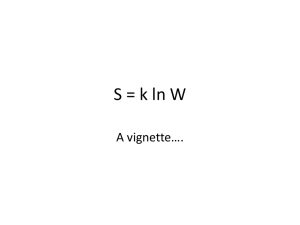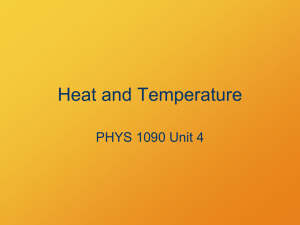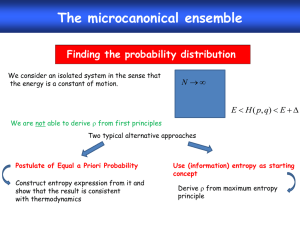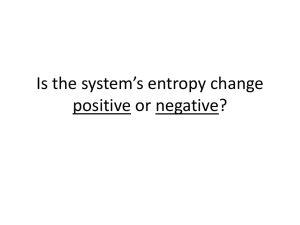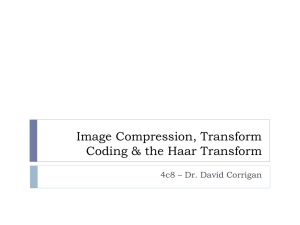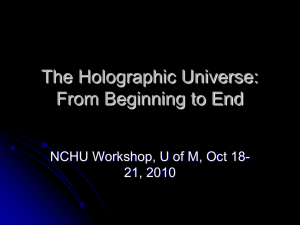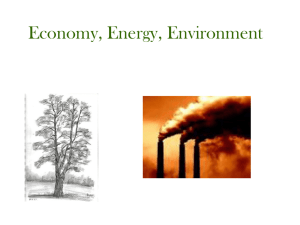entropy in SOFT MATTER PHYSICS
advertisement
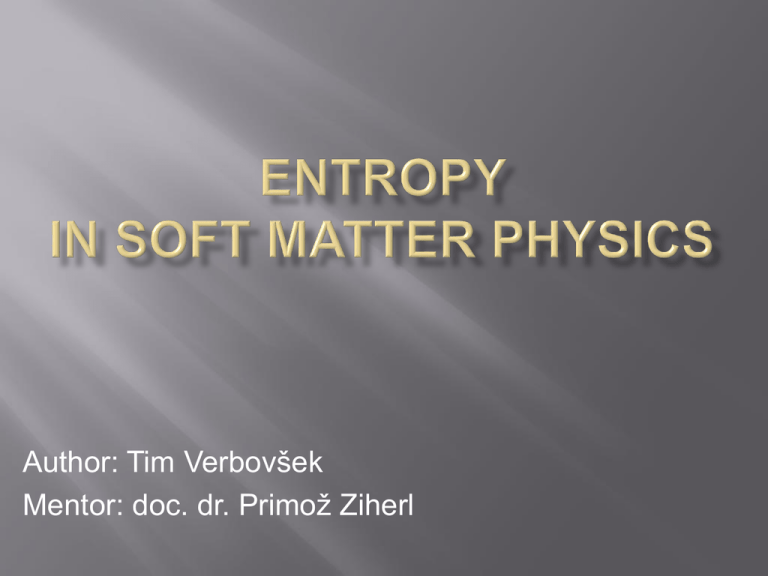
Author: Tim Verbovšek Mentor: doc. dr. Primož Ziherl Entropy Polymers Depletion potential Experiment Liquid crystals Simulation Entropy in soft matter physics 2nd Law of thermodynamics In equilibrium, the system has maximal entropy Written in mathematical form by Rudolf Clausius 𝑑𝑆 ≥ 𝑑𝑄 Free energy 𝑇 ℱ = 𝑈 − 𝑇𝑆 Hard-core interactions ∞ 𝑈= 0 Entropy in soft matter physics Macrostate: property of the system Microstate: state of a subunit of the system Ω statistical weight Different sets of microstates for a given macrostate 𝑆 = 𝑘𝐵 ln Ω if all sets of microstates are equally probable 𝑆 = − 𝑘𝐵 𝑝𝑖 ln 𝑝𝑖 Entropy in soft matter physics Entropy in soft matter physics Long chains Random walk Real polymer chains Entropic spring Entropy in soft matter physics Random walk Persistence length Gaussian probability distribution of the end-to-end vector size |𝒓| 𝑃 𝒓, 𝑁 = 3 2𝜋𝑁𝑎2 3 2 3𝒓2 exp(− ) 2𝑁𝑎2 Configurational entropy: Approximate length at which the polymer loses rigidity 𝑆 𝒓 = 3𝑘𝐵 𝒓2 − 2𝑁𝑎2 + 𝑐𝑜𝑛𝑠𝑡𝑎𝑛𝑡 Free energy: ℱ 𝒓 = 3𝑘𝐵 𝑇𝒓2 + 2𝑁𝑎2 + 𝑐𝑜𝑛𝑠𝑡𝑎𝑛𝑡 Entropy in soft matter physics Entropy in soft matter physics Correlation of neighbouring bonds Finite bond angle Excluded volume Self-avoiding walk; the polymer cannot intersect itself The coil takes up more space Entropy in soft matter physics Macrospheres and microspheres Exclusion zone Asakura-Oosawa model (1954) The result of overlapping exclusion zones is an attractive force between macrospheres Microscopic image of milk. Droplets of fat can be seen. Entropy in soft matter physics An excluded zone appears around the plate submerged in a solution of microspheres 𝑉 = 2𝐴𝜎 Entropy in soft matter physics Exclusion zones overlap, leading to a larger available volume for the microspheres 𝑉 = 𝐴(𝜎 + 𝑑) Entropy in soft matter physics Ideal gas of microspheres Free energy is ℱ = −𝑁𝑘𝐵 𝑇 ln 𝑉′ Entropic force: 𝐹 = Two spheres: 1 4 𝐹 = −ρ𝑘𝐵 𝑇π((𝑟 + 𝑅)2 − 𝑑 2 ) Wall-sphere: 𝜕ℱ − 𝜕𝑑 𝐹 = −ρ𝑘𝐵 𝑇π(3𝑅 + 𝑑)(2r − R − d) Short ranged interactions Entropy in soft matter physics Silica beads (𝑑 ≈ 1.25 𝜇𝑚) were suspended in a solution of λ-DNA polymers (𝑅𝑔 ≈ 500 𝑛𝑚) Measurement of the positions of the beads gives the probability distribution P(r) 𝑃(𝑟) ∝ 𝑒 −𝑈(𝑟) 𝑘𝐵 𝑇 Entropy in soft matter physics Optical tweezers hold the beads in place The potential as a result of optical tweezers was found to be parabolic Entropy in soft matter physics Entropy in soft matter physics Experiment gives a good fit to the AsakuraOosawa model The range of the depletion potential was found to be 𝑑 = 2(𝑅 + 𝑟) Depth of the potential increases linearly with polymer concentration 1 4 𝐹 = −ρ𝑘𝐵 𝑇π((𝑟 + 𝑅)2 + 𝑑 2 ) Entropy in soft matter physics Isotropic phase Nematic phase Director Positions of the centers of mass are isotropic Smectic phase Layers Smectic A Smectic C Columnar Disk-shaped molecules Entropy in soft matter physics Onsager theory (1949) Solid rod model 𝑆 = 𝑆𝑜 + 𝑆𝑝 𝑆𝑜 - orientational entropy Has a maximum in the isotropic phase 𝑆𝑝 - packing entropy It is maximised when the molecules are parallel The same role as the depletion potential in colloidal dispersions It is a linear function of the concentration of rods Entropy in soft matter physics Lyotropic liquid crystals: Phase changes occur by changing the molecule concentration (T = const.) Computer simulations for hard spherocylinders Shape anisotropy parameter 𝐿/𝐷 Length-to-width ration 𝐿+𝐷 𝐷 Entropy in soft matter physics Entropy in soft matter physics Entropy Polymers Entropic spring Depletion potential With hard spheres and constant temperature, the free energy depends only on entropy Short-range attraction between colloids Experiment Liquid crystals Phase transitions Simulation Entropy in soft matter physics

